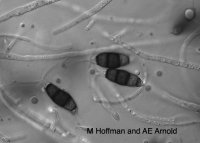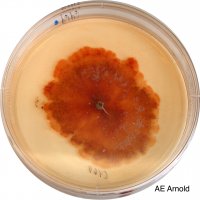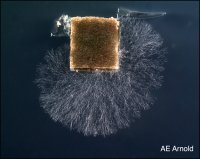Taxonomic
Dimensions of Biodiversity: An Interdisciplinary Study of Hyperdiverse Endophytic Fungi and their Function in Boreal Forests
Aim 2: Establish transformative taxonomic practices and select optimal model systems for functional and genetic studies
For additional information, contact François Lutzoni (flutzoni@duke.edu)
The primary bottleneck in describing taxonomic diversity of newly discovered fungi reflects three interacting factors. (1) The traditional practice of describing new fungal species on the basis of reproductive structures excludes the many fungi that rarely reproduce in culture or for which reproductive structures are unknown in nature. (2) The lack of DNA sequences from previously described, morphologically delimited species prevents connections between known fungi and sterile mycelia or environmental samples. (3) The immense diversity of Ascomycota is so overwhelming that current practices are too slow to make significant progress.
Our goal to synergize fungal taxonomy and molecular systematics for more rapid and accurate circumscription and naming of species by (a) establishing new partnerships among ecologists, taxonomists, molecular systematists, and population geneticists, (b) enhancing interactivity among online databases, herbaria and culture collections, (c) developing new analytical and bioinformatics tools for more rapid and accurate species circumscription, (d) introducing this new approach through a major workshop at the CBS Fungal Biodiversity Center, and (e) training visiting fungal taxonomists at Duke University.
To address (2) above, the DNA barcoding initiative recently has catalyzed DNA sequencing from specimens in major fungal herbaria and culture collections (e.g., Royal Botanic Garden, Kew, and CBS Fungal Biodiversity Center). Through an agreement with CBS, we will fuse unpublished data from that large-scale effort with our existing database of all relevant ITS/ITS-LSU sequences from GenBank, AFToL, our surveys to date, and the extensive set of novel sequences generated by this project.
To address (1) and (3), we then propose to use phylogenetic and population genetic methods to first estimate the circumscription of fungal species, and then, through collaboration with taxonomic experts, seek functional and phenotypic traits for the description and naming process. This global approach is needed to accurately infer endophyte relationships and taxonomic boundaries and requires two steps: (1) recognition of shallow (relatively low genetic variation) monophyletic entities based on ITS-LSU data, including individuals and populations with a limited amount of genetic variation; and (2) detection of divergence and isolation within shallow clades of populations and putative sister species. These efforts will be complemented by 8-locus analyses in the Pezizomycotina, enhancing our understanding of the structure of the Ascomycota tree.
Pipeline development. We will develop a new bioinformatics pipeline to make this process efficient, powerful, accurate, and fast. Housed in our SNAP workspace and accessible through our web portal, the pipeline will provide a novel toolkit to researchers for (1) estimating genetic species boundaries through population- and phylogenetic-level analyses, and (2) determining more accurately the phylogenetic placement of unknown strains. Putative species that have been circumscribed analytically will be distributed to relevant taxonomic experts to be described and named. Initially, this will be done through one major workshop at CBS, and by hosting visiting fungal taxonomists at Duke University (below).
Pipeline distribution and enhancements of fungal taxonomy. We will organize a Fungal Taxonomy Workshop at CBS during year 3 of this project, through which the PIs will demonstrate our new biodiversity informatics tools and resulting putative species circumscriptions. In year 4, we will co-organize a symposium at IMC10 to present this new approach. Finally, we have committed to host a total of four visitors (Ph.D. students, postdoctoral researchers, and more senior researchers) with taxonomic expertise, for periods of 3-4 months (see budget justification) at Duke University. The goal will be for these taxonomists to describe new species resulting from our project while gaining expertise in fungal molecular systematics, phylogenetics, and population genetics.
Bioinformatics team. We have assembled an extensive group of bioinformaticians with complementary expertise in establishing (a) bioinformatics pipelines for large-scale phylogenetic projects: Frank Kauff and François Lutzoni, WASABI for AFTOL; (b) the leading program for analysis of very large data sets using maximum likelihood: Alexandros Stamatakis, RAxML, including the evolutionary placement of short sequence reads on multi-core architectures; and (c) a new Bayesian method to capture phylogenetic signal from ambiguously aligned sequences due to indels: Benjamin Redelings, BALi-Phy, which we have applied to extract information from fungal ITS sequences at relatively deep phylogenetic levels. These computational biologists and computer scientists will join Ignazio Carbone, who has developed a comprehensive package of population genetic tools (SNAP Workbench, other tools) and an associated web portal (http://servbio.hpc.ncsu.edu:81/mobyle/cgi-bin/dev1/portal.py) to allow computationally intensive programs to execute on multiple nodes. This coalition of expertise covers all major technical and theoretical challenges intrinsic to our bioinformatics pipeline and provides the analytical tools needed to demarcate populations from species within a large-scale phylogenetic framework.








